Can Environmental Quality Improvement and Emission Reduction Targets Be Realized Simultaneously? Evidence from China and A Geographically and Temporally Weighted Regression Model
Abstract
1. Introduction
2. Methodology and Data
2.1. Methodology
2.1.1. Vertical and Horizontal Scatter Degree Method
- Data standardization:where m represents the province, and m = 1, 2, ..., 30. n is the index, and n = 1, 2, 3, and 4. t is the year, and t = 1997, 1998, ..., 2015. X*m,n,t represents the value of a parameter after standardization. xm,n,t is a “raw” datum before standardization. is the mean value of n indexes in 30 provinces in year t. δn,t is the standard deviation of n indexes in 30 provinces in year t.
- Calculation of the real symmetric matrix:where Ht and H are the real symmetric matrices, and XTt is the transpose matrix of Xt.
- Calculation of the comprehensive index:where Xm,t is the comprehensive index in province m in the year t. wn is the weight, which is the normalization of the eigenvector corresponding to the maximum eigenvalue of H. x*m,n,t is the value after the standardization. To facilitate the logarithmic processing of variable data, the calculation is magnified [50].
2.1.2. Geographically and Temporally Weighted Regression Model
2.2. Data Specification
2.3. Framework of the Research
3. Results and Analysis
3.1. Spatial Distribution Characteristics
3.2. Spatial Correlation Characteristics
3.3. Analysis of Parameter Estimates
3.3.1. Effect of Industrial Pollution Emissions on Carbon Intensity
3.3.2. Effect of Economic Growth on Carbon Intensity
3.3.3. Effect of Opening to the Outside World on Carbon Intensity
3.3.4. Effect of Industrial Structure on Carbon Intensity
3.3.5. Effect of Technological Advances on Carbon Intensity
3.3.6. Effect of Population Density on Carbon Intensity
3.4. Decomposition of Spatial-Temporal Heterogeneity for Parameter Estimates
3.5. Spatial-Temporal Heterogeneity Analysis of Parameter Estimates
3.5.1. Industrial Pollution Emissions and Carbon Density in Eastern China
3.5.2. Industrial Pollution Emissions and Carbon Density in Central China
3.5.3. Industrial Pollution Emissions and Carbon Density in Western China
4. Conclusions and Policy Implications
- (1)
- Adjust energy mix and change development mode
- (2)
- Promote industry transfer and control the flow of pollution
- (3)
- Introduce advanced equipment and adopt high technology and new technology
- (4)
- Strengthen the legal system and play a role of government
Author Contributions
Funding
Conflicts of Interest
Appendix A
Appendix B
References
- Yang, L.X.; Xia, H.; Zhang, X.L.; Yuan, S.F. What matters for carbon emissions in regional sectors? A China study of extended STIRPAT model. J. Clean. Prod. 2018, 180, 595–602. [Google Scholar] [CrossRef]
- Dong, F.; Long, R.Y.; Yu, B.L.; Wang, Y.; Li, J.Y.; Wang, Y.; Dai, Y.J.; Yang, Q.L.; Chen, H. How can China allocate CO2 reduction targets at the provincial level considering both equity and efficiency? Evidence from its Copenhagen Accord pledge. Resour. Conserv. Recycl. 2018, 130, 31–43. [Google Scholar] [CrossRef]
- Dong, F.; Yu, B.; Hadachin, T.; Dai, Y.J.; Wang, Y.; Zhang, S.N.; Long, R.Y. Drivers of carbon emission intensity change in China. Resour. Conserv. Recycl. 2018, 129, 187–201. [Google Scholar] [CrossRef]
- Pretis, F.; Roser, M. Carbon dioxide emission-intensity in climate projections: Comparing the observational record to socio-economic scenarios. Energy 2017, 135, 718–725. [Google Scholar] [CrossRef] [PubMed]
- Dong, F.; Long, R.Y.; Li, Z.L.; Dai, Y.J. Analysis of carbon emission intensity, urbanization and energy mix: Evidence from China. Nat. Hazards 2016, 82, 1375–1391. [Google Scholar] [CrossRef]
- Dong, F.; Bian, Z.F.; Yu, B.L.; Wang, Y.; Zhang, S.N.; Li, J.Y.; Su, B.; Long, R.Y. Can land urbanization help to achieve CO2 intensity reduction target or hinder it? Evidence from China. Resour. Conserv. Recycl. 2018, 134, 206–215. [Google Scholar] [CrossRef]
- Yu, S.W.; Zheng, S.H.; Zhang, X.J.; Gong, C.Z.; Cheng, J.H. Realizing China’s goals on energy saving and pollution reduction: Industrial structure multi-objective optimization approach. Energy Policy 2018, 122, 300–312. [Google Scholar] [CrossRef]
- Chang, K.; Ge, F.P.; Zhang, C.; Wang, W.H. The dynamic linkage effect between energy and emissions allowances price for regional emissions trading scheme pilots in China. Renew. Sust. Energy Rev. 2018, 98, 415–425. [Google Scholar] [CrossRef]
- Dong, H.J.; Dai, H.C.; Geng, Y.; Fujita, T.; Liu, Z.; Xie, Y.; Wu, R.; Fujii, M.; Masui, T.; Tang, L. Exploring impact of carbon tax on China’s CO2 reductions and provincial disparities. Renew. Sust. Energy Rev. 2017, 77, 596–603. [Google Scholar] [CrossRef]
- Shi, L.Y.; Sun, J.; Lin, J.Y. Factor decomposition of carbon emissions in Chinese megacities. J. World Econ. 2018, in press. [Google Scholar] [CrossRef]
- Gu, A.L.; Teng, F.; Feng, X.Z. Aeeseement and Analysis on Co-benefits of Pollution Control and Greenhouse Gases Emission Redution in Key Sectors. China Popul. Resour. Environ. 2016, 26, 10–17. (In Chinese) [Google Scholar]
- Nam, K.M.; Waugh, C.J.; Paltsev, S.; Reilly, J.M.; Karplus, V.J. Synergy between pollution and carbon emissions control: Comparing China and the United States. Energ. Econ. 2014, 46, 186–201. [Google Scholar] [CrossRef]
- Intergovernmental Panel on Climate Change (IPCC). Synthesis Report. Contribution of Working Groups I, II & III to the Fourth Assessment Report of the Intergovernmental Panel on Climate Chang; IPCC: Geneva, Switzerland, 2007. [Google Scholar]
- Fu, J.Y.; Yuan, Z.L. Evaluation of effect and analysis of expansion mechanism of synergic emission abatement in China’s power industry. China Ind. Econ. 2017, 2, 43–59. (In Chinese) [Google Scholar]
- Fan, Y.; Liu, L.C.; Wu, G.; Wei, Y.M. Analyzing impact factors of CO2 emissions using the STIRPAT model. Environ. Impact Asses. Rev. 2006, 26, 377–395. [Google Scholar] [CrossRef]
- Ang, B.W.; Zhang, F.Q. Inter-regional comparisons of energy-related CO2 emissions using the decomposition technique. Energy 1999, 24, 297–305. [Google Scholar] [CrossRef]
- Ebohon, O.J.; Ikeme, A.J. Decomposition analysis of CO2 emission intensity between oil-producing and non-oil-producing sub-Saharan African countries. Energy Policy 2006, 34, 3599–3611. [Google Scholar] [CrossRef]
- Li, A.J.; Zhang, A.Z.; Zhou, Y.X.; Yao, X. Decomposition analysis of factors affecting carbon dioxide emissions across provinces in China. J. Clean. Prod. 2017, 141, 1428–1444. [Google Scholar] [CrossRef]
- Wang, Q.W.; Chiu, Y.H.; Chiu, C.R. Driving factors behind carbon dioxide emissions in china: A modified production-theoretical decomposition analysis. Energy Econ. 2015, 51, 252–260. [Google Scholar] [CrossRef]
- Wang, S.J.; Ma, Y.Y. Influencing factors and regional discrepancies of the efficiency of carbon dioxide emissions in Jiangsu, China. Ecol. Indic. 2018, 90, 460–468. [Google Scholar] [CrossRef]
- Wang, Y.; Chen, W.; Kang, Y.Q.; Li, W.; Guo, F. Spatial correlation of factors affecting CO2 emission at provincial level in China: A geographically weighted regression approach. J. Clean. Prod. 2018, 184, 929–937. [Google Scholar] [CrossRef]
- Wang, P.; Wu, W.S.; Zhu, B.Z.; Wei, Y.M. Examining the impact factors of energy-related CO2 emissions using the STIRPAT model in Guangdong Province, China. Appl. Energy 2013, 106, 65–71. [Google Scholar] [CrossRef]
- Li, H.N.; Mu, H.L.; Zhang, M.; Gui, S.S. Analysis of regional difference on impact factors of China’s energy—Related CO2 emissions. Energy 2012, 39, 319–326. [Google Scholar] [CrossRef]
- Fu, B.T.; Wu, M.; Che, Y.; Wang, M.; Huang, Y.C.; Bai, Y. The strategy of a low-carbon economy based on the STIRPAT and SD models. Acta Ecol. Sin. 2015, 35, 76–82. [Google Scholar] [CrossRef]
- Han, X.L.; Chatterjee, L. Impacts of growth and structural change on CO2 emissions of developing countries. World Dev. 1997, 25, 395–407. [Google Scholar] [CrossRef]
- Al-Mulali, U. Factors affecting CO2 emission in the Middle East: A panel data analysis. Energy 2012, 44, 564–569. [Google Scholar] [CrossRef]
- Shuai, C.Y.; Shen, L.Y.; Jiao, L.D.; Wu, Y.; Tan, Y.T. Identifying key impact factors on carbon emission: Evidences from panel and time-series data of 125 countries from 1990 to 2011. Appl. Energy 2017, 187, 310–325. [Google Scholar] [CrossRef]
- Zhang, C.G.; Lin, Y. Panel estimation for urbanization, energy consumption and CO2 emissions: A regional analysis in China. Energy Policy 2012, 49, 488–496. [Google Scholar] [CrossRef]
- Zhu, Q.; Peng, X.Z.; Lu, Z.M.; Wu, K.Y. Factors decomposition and empirical analysis of variations in energy carbon emission in China. Resour. Sci. 2009, 31, 2072–2079. (In Chinese) [Google Scholar]
- Cheng, Z.H.; Li, L.S.; Liu, J. The emissions reduction effect and technical progress effect of environmental regulation policy tools. J. Clean. Prod. 2017, 149, 191–205. [Google Scholar] [CrossRef]
- Dong, F.; Yu, B.L.; Zhang, J.X. What contributes to regional disparities of energy consumption in China? Evidence from quantile regression-Shapley decomposition approach. Sustainability 2018, 10, 1806. [Google Scholar] [CrossRef]
- New China News Agency. Outline of the Thirteenth Year Plan for National Economy and Social Development in People’s Republic of China. Available online: http://www.xinhuanet.com/politics/2016lh/2016-03/17/c_1118366322.htm (accessed on 17 September 2016).
- Gong, X.S.; Zhang, H.Z.; Pan, M.M. Market competition, environmental regulation and industrial pollution emissions. China Popul. Resour. Environ. 2017, 27, 52–58. (In Chinese) [Google Scholar]
- Cheng, J.H.; Dai, S.; Ye, X.Y. Spatiotemporal heterogeneity of industrial pollution in China. China Econ. Rev. 2016, 40, 179–191. [Google Scholar] [CrossRef]
- Wang, C.R.; Du, X.M.; Liu, Y. Measuring spatial spillover effects of industrial emissions: A method and case study in Anhui province, China. J. Clean. Prod. 2017, 141, 1240–1248. [Google Scholar] [CrossRef]
- Zhang, Z.L.; Chen, X.P.; Lu, C.P. Empirical Analysis on Dynamic Changes of Industrial Environmental Performance in China. Stat. Decis. 2015, 12, 113–115. (In Chinese) [Google Scholar]
- Liang, D.P.; Liu, T.S. Does environmental management capability of Chinese industrial firms improve the contribution of corporate environmental performance to economic performance? Evidence from 2010 to 2015. J. Clean. Prod. 2017, 142, 2985–2998. [Google Scholar] [CrossRef]
- Chen, J.D.; Wang, Y.; Song, M.L.; Zhao, R.C. Analyzing the decoupling relationship between marine economic growth and marine pollution in China. Ocean Eng. 2017, 137, 1–12. [Google Scholar] [CrossRef]
- Wang, W.X.; Yu, B.; Yao, X.L.; Niu, T.; Zhang, C.T. Can technological learning significantly reduce industrial air pollutants intensity in China?—Based on a multi-factor environmental learning curve. J. Clean. Prod. 2018, 185, 137–147. [Google Scholar] [CrossRef]
- Zhou, Y.; Zhu, S.J.; He, C.F. How do environmental regulations affect industrial dynamics? Evidence from China’s pollution-intensive industries. Habitat Int. 2017, 60, 10–18. [Google Scholar] [CrossRef]
- Chang, M.; Zheng, J.; Inoue, Y.; Tian, X.; Chen, Q.; Gan, T.T. Comparative analysis on the socioeconomic drivers of industrial air-pollutant emissions between Japan and China: Insights for the further-abatement period based on the LMDI method. J. Clean. Prod. 2018, 189, 240–250. [Google Scholar] [CrossRef]
- Wang, Q.; Yuan, B.L. Air pollution control intensity and ecological total-factor energy efficiency: The moderating effect of ownership structure. J. Clean. Prod. 2018, 186, 373–387. [Google Scholar] [CrossRef]
- Hou, J.; Teo, T.S.H.; Zhou, F.L.; Ming, K.L.; Chen, H. Does industrial green transformation successfully facilitate a decrease in carbon intensity in China? An environmental regulation perspective. J. Clean. Prod. 2018, 184, 1060–1071. [Google Scholar] [CrossRef]
- Li, W.; Sun, W.; Li, G.M.; Cui, P.F.; Wu, W.; Jin, B.H. Temporal and spatial heterogeneity of carbon intensity in China’s construction industry. Resour. Conserv. Recycl. 2017, 126, 162–173. [Google Scholar] [CrossRef]
- Yan, D.; Lei, Y.L.; Li, L.; Song, W. Carbon emission efficiency and spatial clustering analyses in China’s thermal power industry: Evidence from the provincial level. J. Clean. Prod. 2017, 156, 518–527. [Google Scholar] [CrossRef]
- Fu, Y.P.; Ma, S.C.; Song, Q. Spatial econometric analysis of regional carbon intensity. Stat. Res. 2015, 32, 67–73. [Google Scholar]
- Hao, Y.; Liu, Y.M. The influential factors of urban PM 2.5 concentrations in China: A spatial econometric analysis. J. Clean. Prod. 2016, 112, 1443–1453. [Google Scholar] [CrossRef]
- Li, W.; Sun, W.; Li, G.M.; Jin, B.H.; Wu, W.; Cui, P.F. Transmission mechanism between energy prices and carbon emissions using geographically weighted regression. Energy Policy 2018, 115, 434–442. [Google Scholar] [CrossRef]
- Xiao, L.; Lang, Y.C.; Christakos, G. High-resolution spatiotemporal mapping of PM 2.5 concentrations at mainland China using a combined bme-gwr technique. Atmos. Environ. 2018, 173, 295–305. [Google Scholar] [CrossRef]
- Shen, G.B.; Zhang, X. The impact of openness and economic growth on China’s provincial industrial pollution emissions. J. World Econ. 2015, 4, 99–125. (In Chinese) [Google Scholar]
- Du, Z.H.; Wu, S.S.; Zhang, F.; Liu, R.Y.; Zhou, Y. Extending geographically and temporally weighted regression to account for both spatiotemporal heterogeneity and seasonal variations in coastal seas. Ecol. Inform. 2018, 43, 185–199. [Google Scholar] [CrossRef]
- Johnson, B.A.; Scheyvens, H.; Baqui, M.A.; Onishi, A. Investigating the relationships between climate hazards and spatial accessibility to microfinance using geographically-weighted regression. Int. J. Disaster Risk Redut. 2018, in press. [Google Scholar] [CrossRef]
- Ma, X.L.; Zhang, J.Y.; Ding, C.; Wang, Y.P. A geographically and temporally weighted regression model to explore the spatiotemporal influence of built environment on transit ridership. Comput. Environ. Urban Syst. 2018, 70, 113–124. [Google Scholar] [CrossRef]
- Hu, C.Z.; Huang, X.J. Characteristics of Carbon Emission in China and Analysis on Its Cause. China Popul. Resour. Environ. 2008, 18, 38–42. (In Chinese) [Google Scholar]
- Dong, F.; Long, R.Y.; Bian, Z.F.; Xu, X.H.; Yu, B.L.; Wang, Y. Applying a Ruggiero three stage super-efficiency DEA model to gauge regional carbon emission efficiency: Evidence from China. Nat. Hazards 2017, 87, 1453–1468. [Google Scholar] [CrossRef]
- Intergovernmental Panel on Climate Change (IPCC). IPCC Guidelines for National Greenhouse Gas Inventories; IPCC: Geneva, Switzerland, 2006; Volume II. [Google Scholar]
- Luo, H.J.; Fan, R.G.; Luo, M. Measure and Analysis on the Evolutionary Process of Energy Efficiency in China. J. Quant. Tech. Econ. 2015, 5, 54–71. (In Chinese) [Google Scholar]
- Xiao, G.X.; Hu, Y.L.; Li, N.; Yang, D.J. Spatial autocorrelation analysis of monitoring data of heavy metals in rice in China. Food Control 2018, 89, 32–37. [Google Scholar] [CrossRef]
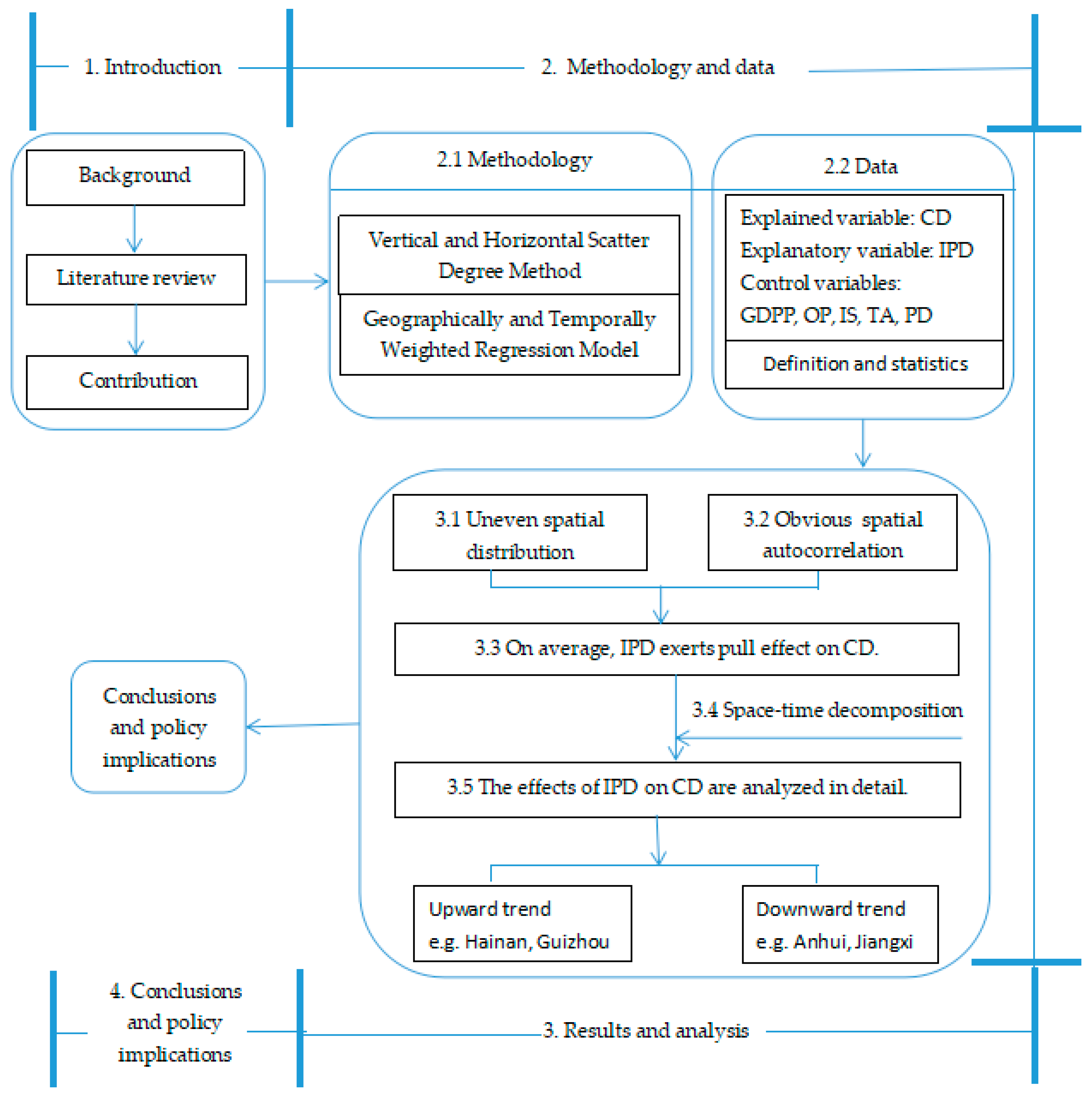
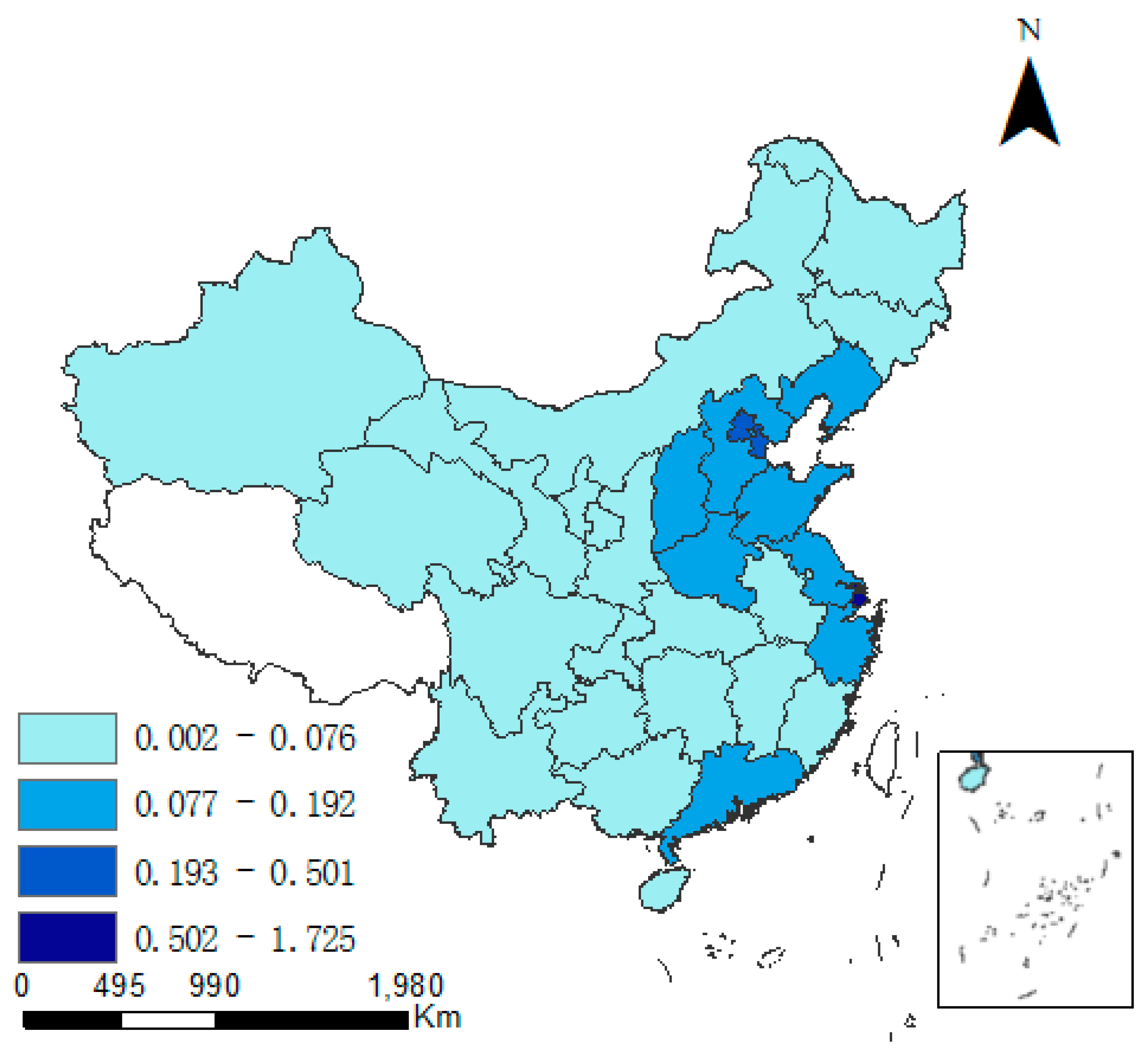
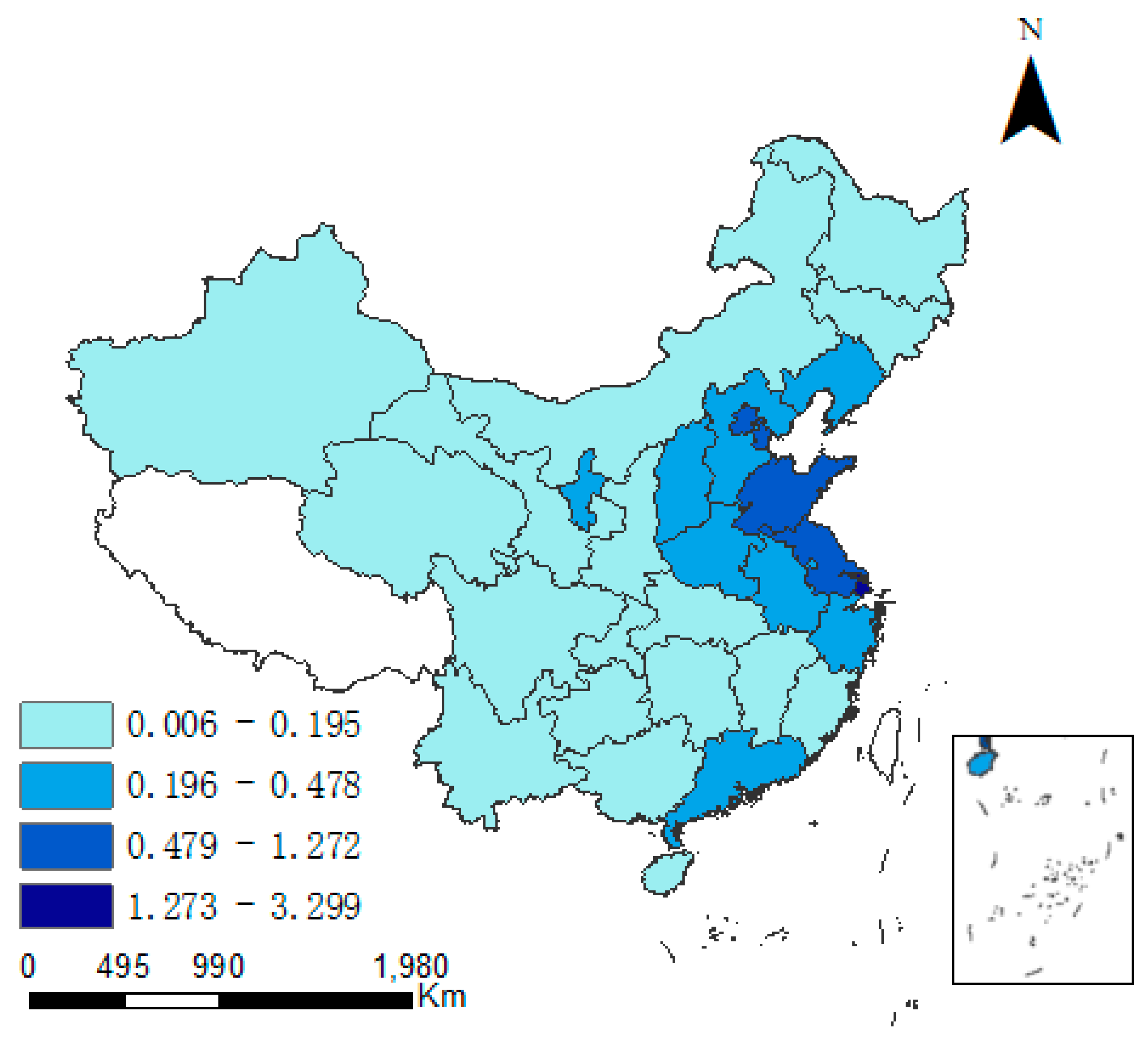
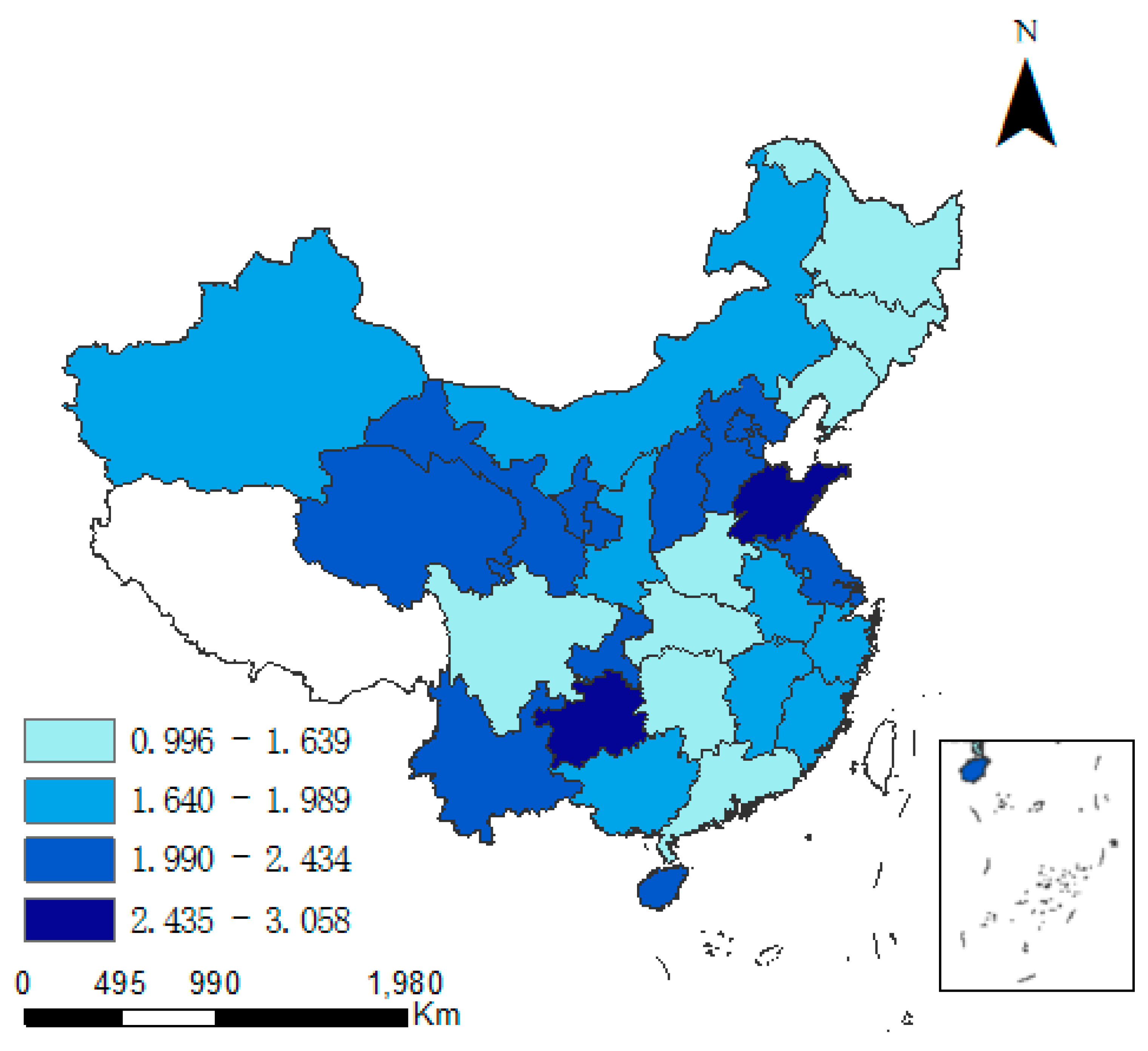
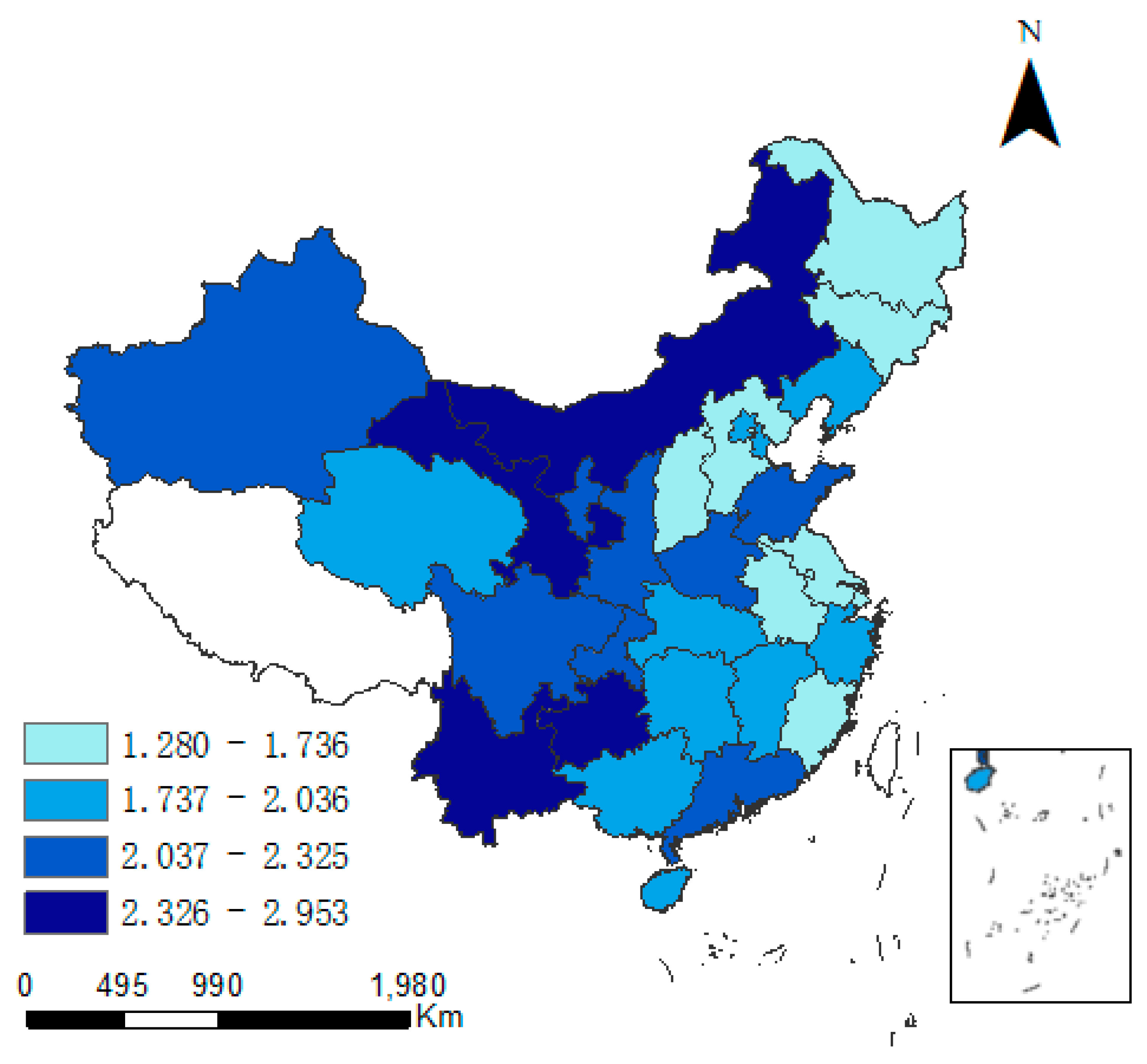
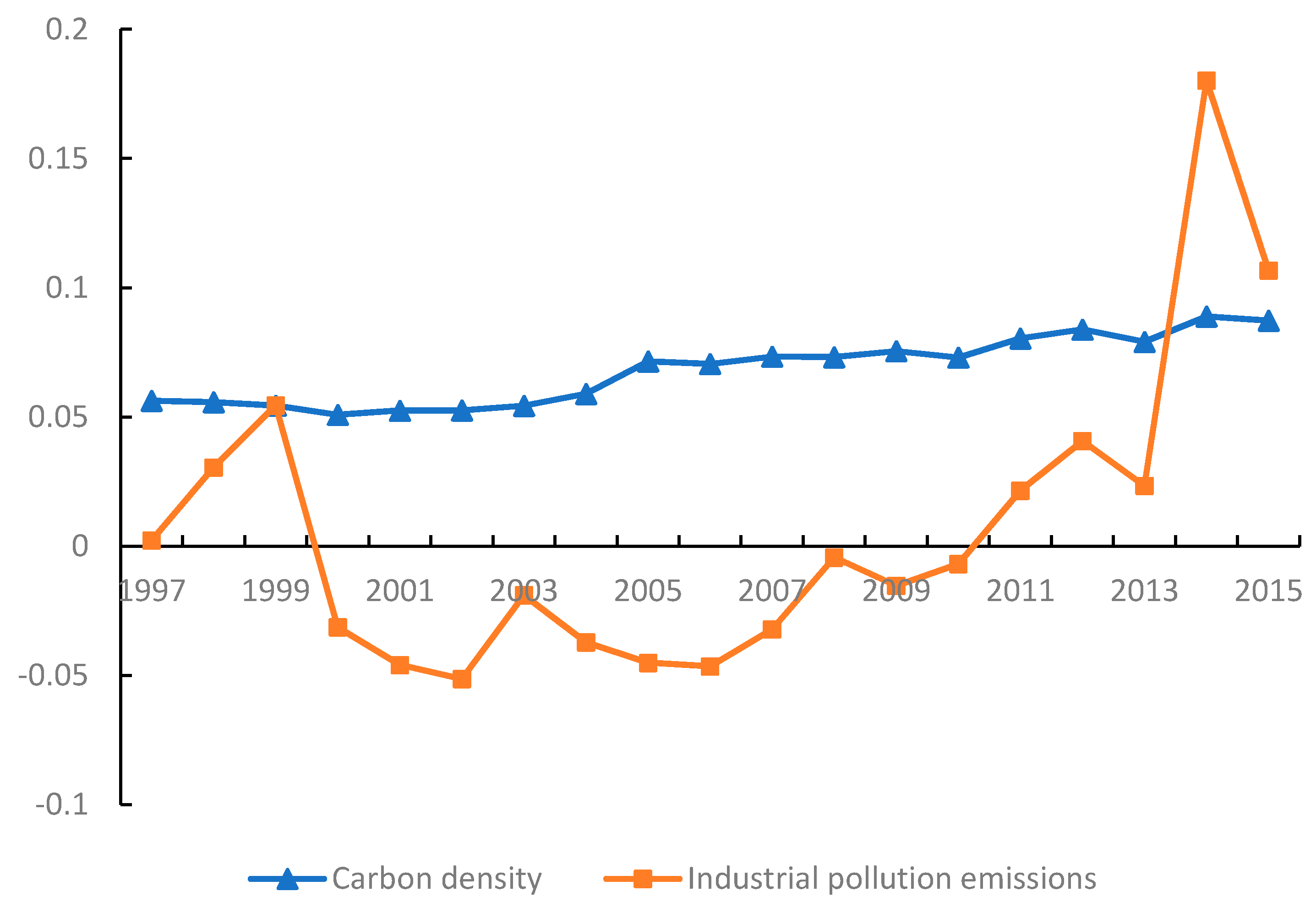
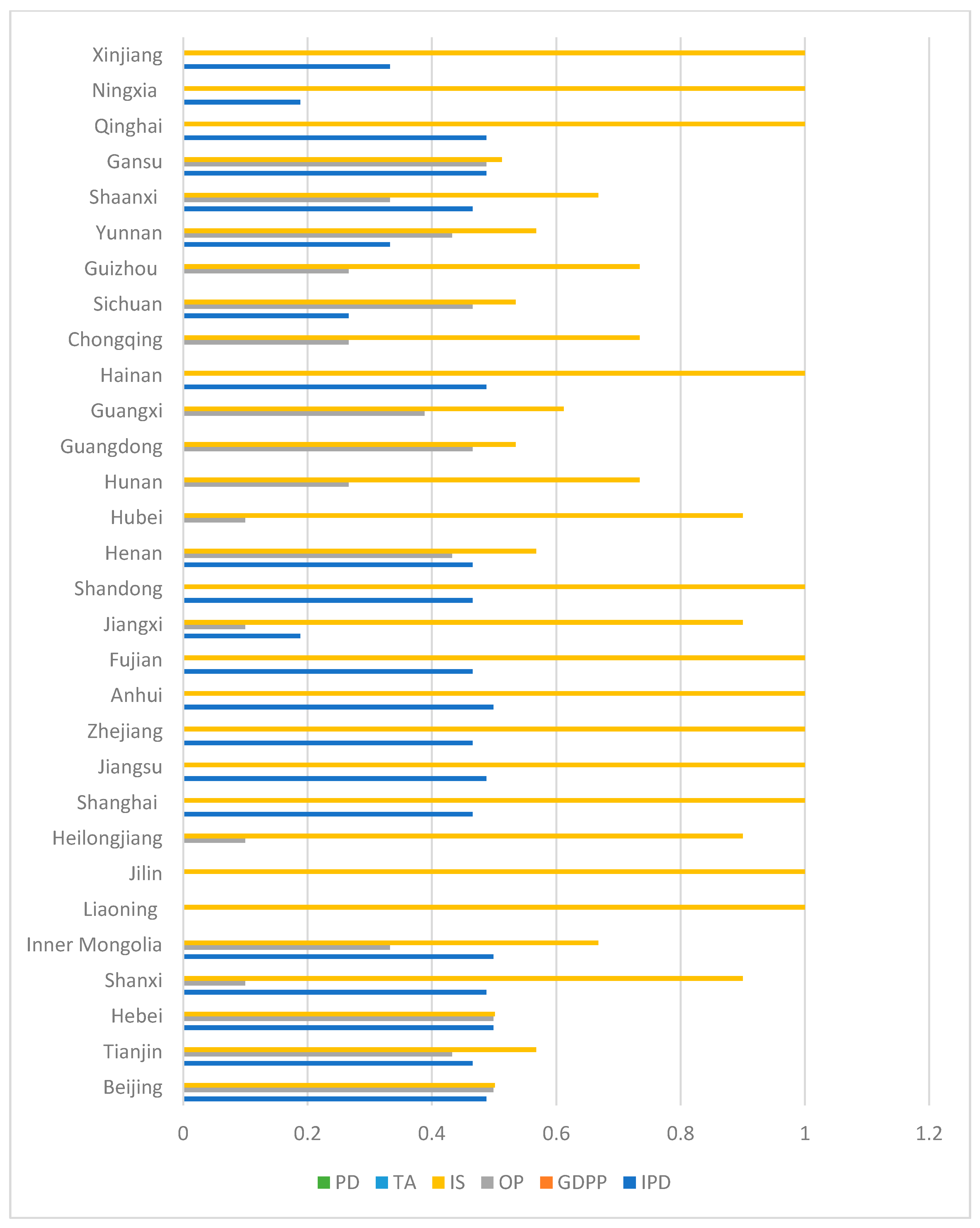
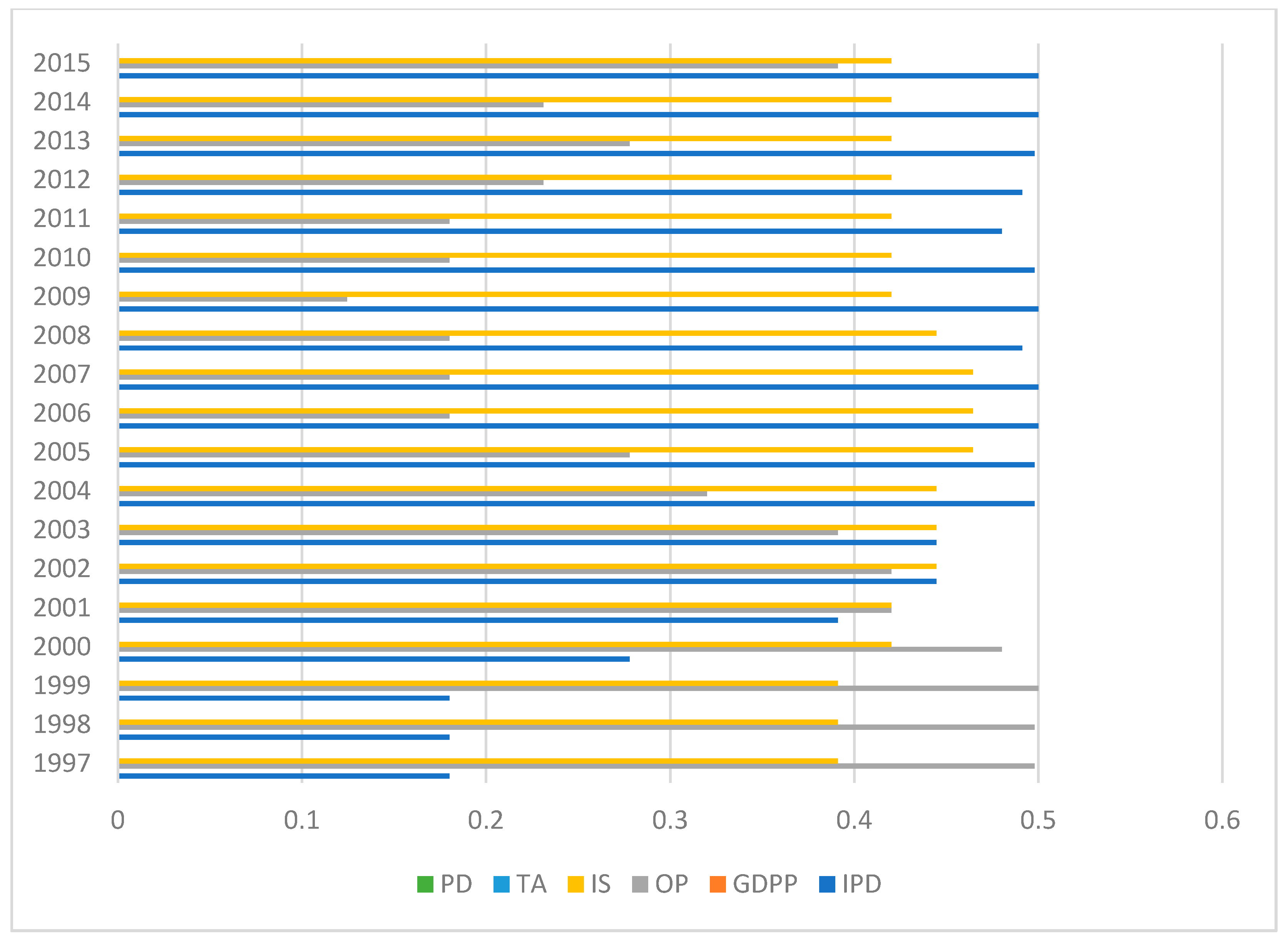
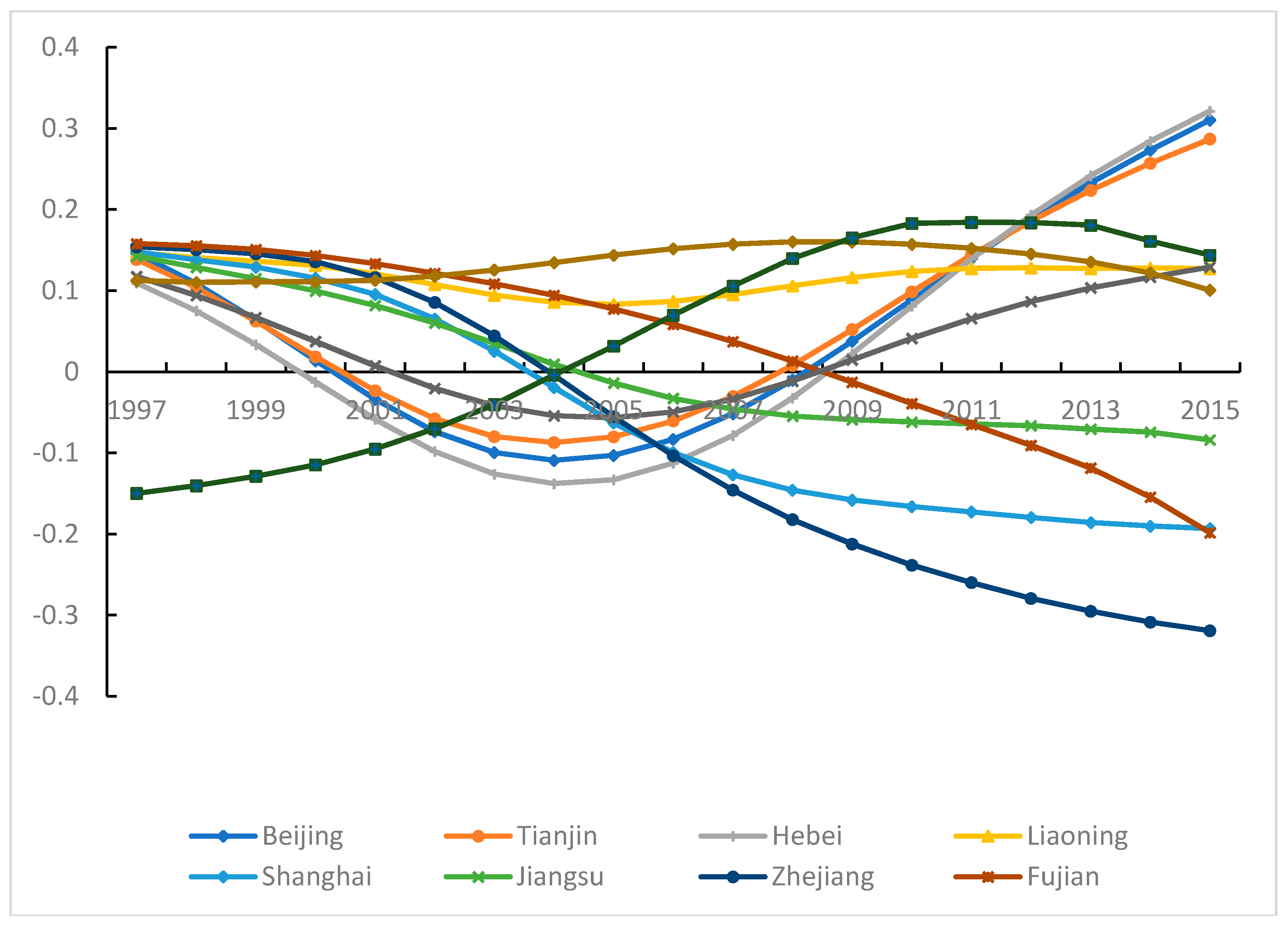
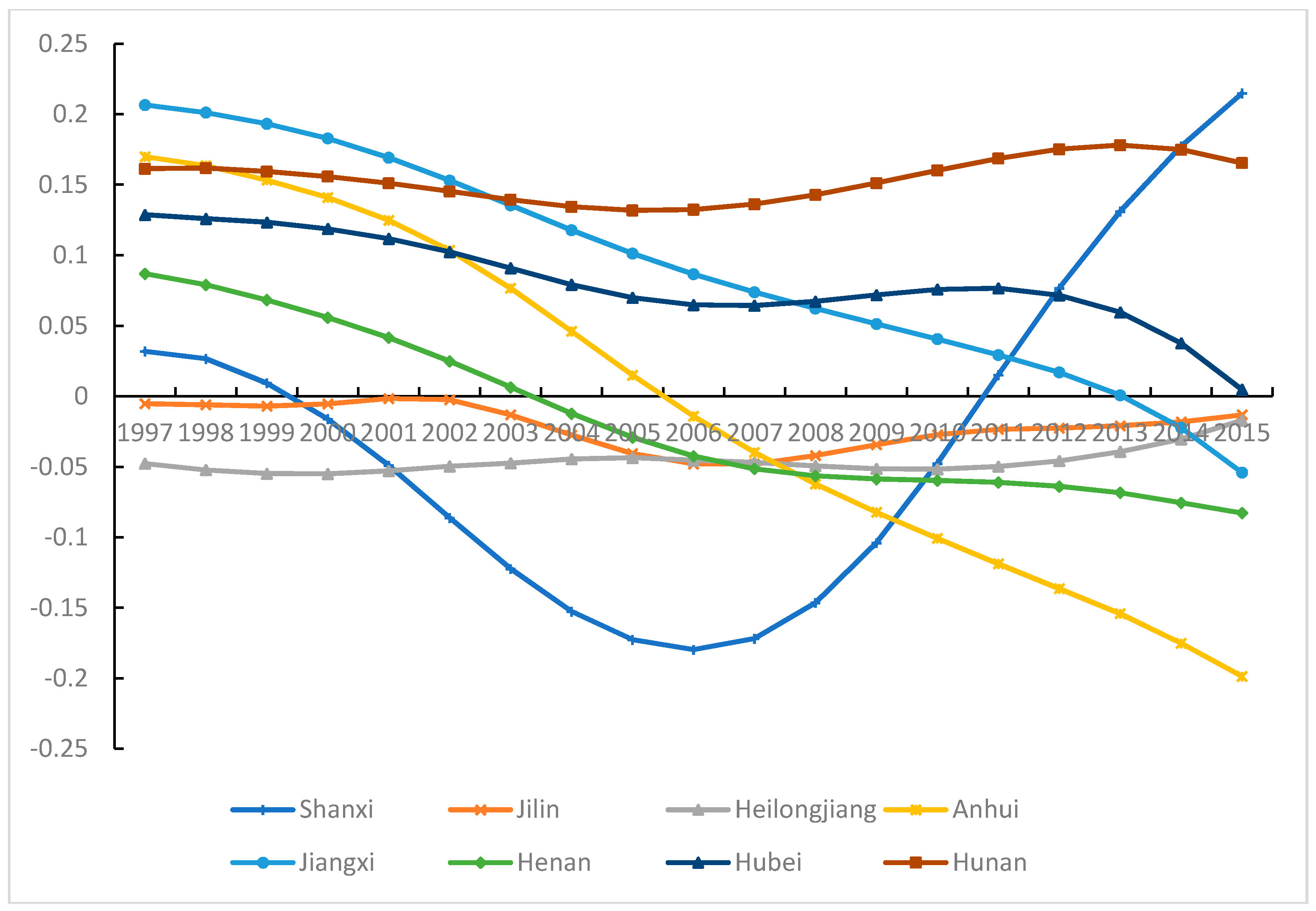

| Variable | Definition | Variable | Definition |
|---|---|---|---|
| Carbon density (CD) | Carbon dioxide emissions/administrative land area (10 K·t/Km2) | Industrial structure (IS) | Second industry added value/GDP (%) |
| Industrial pollution emissions (IPD) | Comprehensive index | Technological advances (TA) | Energy consumption/GDP (t/10 K·yuan) |
| Economic growth (GDPP) | GDP/total population (yuan) | Population density (PD) | Total population/administrative land area (ren/Km2) |
| Opening to the outside world (OP) | Total imports and exports/GDP (%) |
| Variable | Mean | Median | Max | Min | Std. Dev. |
|---|---|---|---|---|---|
| Carbon density | 0.261 | 0.113 | 3.544 | 0.002 | 0.514 |
| Industrial pollution emissions | 2.000 | 1.986 | 3.175 | 0.570 | 0.405 |
| Economic growth | 17,169.490 | 13,393.418 | 69,336.200 | 2195.508 | 12,857.210 |
| Opening to the outside world | 0.330 | 0.126 | 12.806 | 0.032 | 0.653 |
| Industrial structure | 46.470 | 47.700 | 61.500 | 19.700 | 7.599 |
| Technological advances | 1.755 | 1.519 | 5.088 | 0.510 | 0.900 |
| Population density | 0.041 | 0.027 | 0.383 | 0.001 | 0.057 |
| Year | Z-Test | Year | Z-Test | Year | Z-Test | Year | Z-Test |
|---|---|---|---|---|---|---|---|
| 1997 | 0.629 * | 2002 | 0.542 * | 2007 | 0.252 * | 2012 | −0.600 * |
| 1998 | −0.463 * | 2003 | −0.665 * | 2008 | −0.707 * | 2013 | −0.164 * |
| 1999 | −0.663 * | 2004 | −0.042 * | 2009 | −0.397 * | 2014 | 0.118 * |
| 2000 | 0.061 * | 2005 | 1.651 ** | 2010 | 2.385 *** | 2015 | 1.930 ** |
| 2001 | 0.821 * | 2006 | 0.494 * | 2011 | −0.310 * |
| Index | Min | 1/4 Quantile | Median | 3/4 Quantile | Max | Mean |
|---|---|---|---|---|---|---|
| LnIPD | −0.811 | −0.049 | 0.062 | 0.134 | 0.483 | 0.035 |
| LnGDPP | 0.637 | 0.892 | 0.946 | 1.031 | 1.398 | 0.960 |
| LnOP | −0.316 | −0.070 | −0.030 | −0.003 | 0.208 | −0.036 |
| LnIS | −0.955 | −0.120 | 0.298 | 0.479 | 1.388 | 0.193 |
| LnTA | 0.639 | 0.975 | 1.098 | 1.236 | 1.740 | 1.102 |
| LnPD | 0.657 | 0.931 | 1.063 | 1.125 | 2.329 | 1.062 |
© 2018 by the authors. Licensee MDPI, Basel, Switzerland. This article is an open access article distributed under the terms and conditions of the Creative Commons Attribution (CC BY) license (http://creativecommons.org/licenses/by/4.0/).
Share and Cite
Dong, F.; Wang, Y.; Zhang, X. Can Environmental Quality Improvement and Emission Reduction Targets Be Realized Simultaneously? Evidence from China and A Geographically and Temporally Weighted Regression Model. Int. J. Environ. Res. Public Health 2018, 15, 2343. https://doi.org/10.3390/ijerph15112343
Dong F, Wang Y, Zhang X. Can Environmental Quality Improvement and Emission Reduction Targets Be Realized Simultaneously? Evidence from China and A Geographically and Temporally Weighted Regression Model. International Journal of Environmental Research and Public Health. 2018; 15(11):2343. https://doi.org/10.3390/ijerph15112343
Chicago/Turabian StyleDong, Feng, Yue Wang, and Xiaojie Zhang. 2018. "Can Environmental Quality Improvement and Emission Reduction Targets Be Realized Simultaneously? Evidence from China and A Geographically and Temporally Weighted Regression Model" International Journal of Environmental Research and Public Health 15, no. 11: 2343. https://doi.org/10.3390/ijerph15112343
APA StyleDong, F., Wang, Y., & Zhang, X. (2018). Can Environmental Quality Improvement and Emission Reduction Targets Be Realized Simultaneously? Evidence from China and A Geographically and Temporally Weighted Regression Model. International Journal of Environmental Research and Public Health, 15(11), 2343. https://doi.org/10.3390/ijerph15112343





